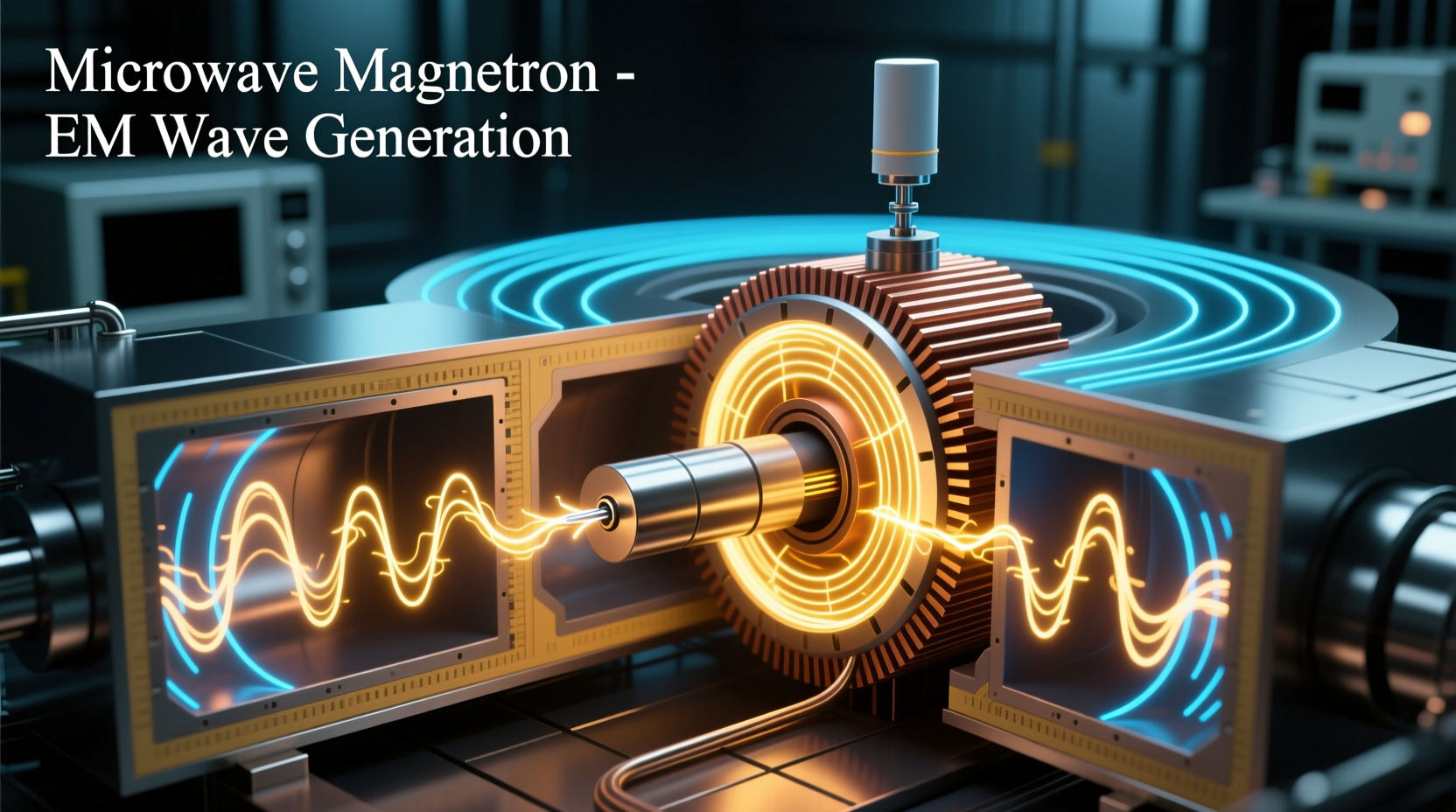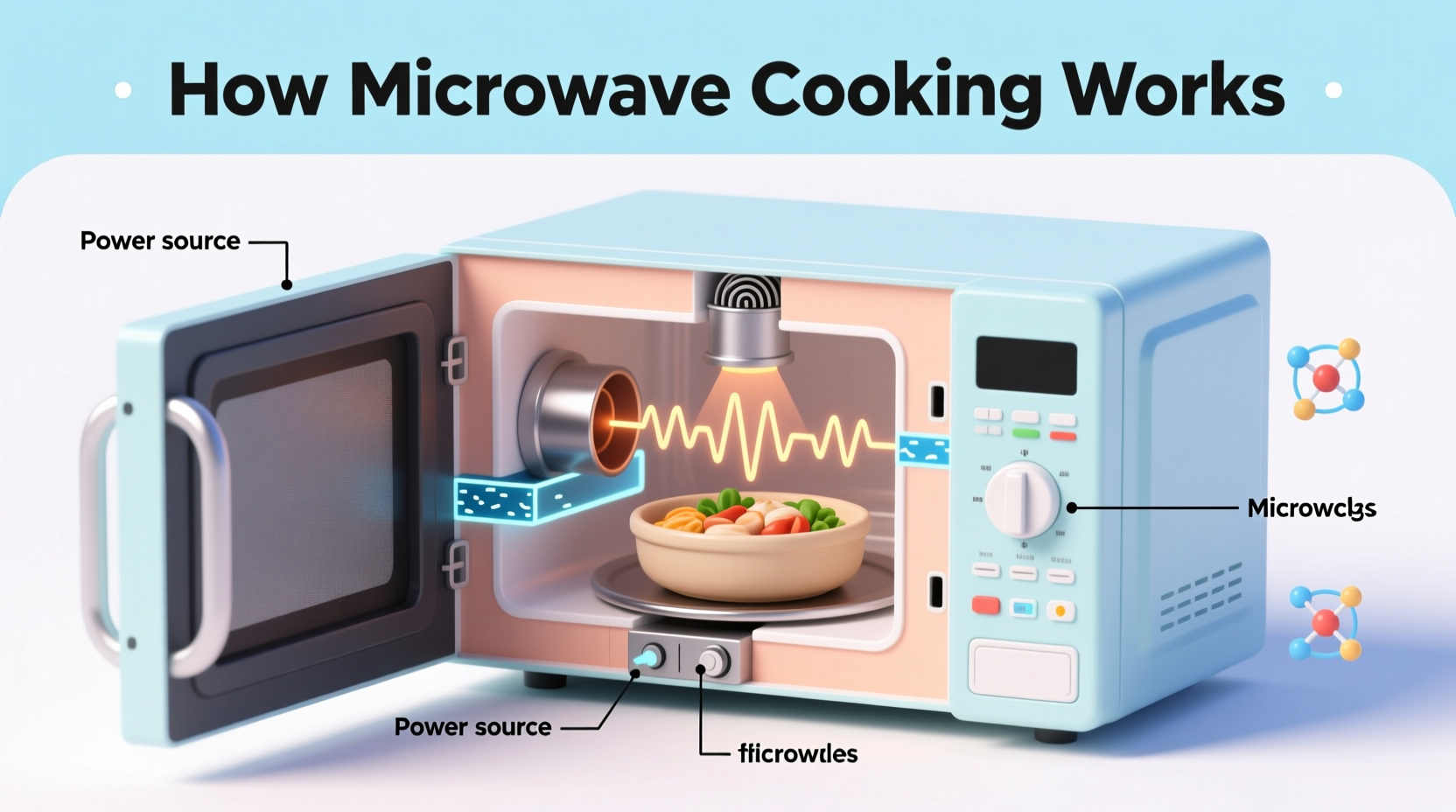The Physics Behind Microwave Heating: More Than Just "Radiation"
When you press start on your microwave, the magnetron converts electricity into electromagnetic waves at a precise frequency of 2.45 gigahertz. This specific frequency was chosen because it efficiently interacts with polar molecules—particularly water, fats, and sugars—found in most foods. As these microwaves penetrate food, they create an oscillating electromagnetic field that causes polar molecules to rapidly rotate and align with the field's changing direction.
This molecular movement generates heat through dielectric heating—a process fundamentally different from conventional cooking methods. While ovens and stovetops transfer heat from the outside inward through conduction, convection, or radiation, microwaves energize molecules throughout the food simultaneously. This explains why microwaves can heat food much faster, though not always more evenly.
Inside Your Microwave: Components Working Together
The key components enabling this process include:
- Magnetron: The heart of your microwave that generates the cooking waves
- Waveguide: A metal channel directing microwaves from the magnetron into the cooking chamber
- Turntable: Rotates food to promote more even exposure to microwave energy
- Stirrer fan (in some models): Distributes waves more uniformly throughout the cavity
Modern microwaves incorporate multiple safety features that prevent operation when the door is open and contain radiation within the cooking chamber. The FDA confirms that microwave ovens meeting federal standards produce less radiation than required to cause harm, with emissions decreasing dramatically at just 2 inches from the oven surface (FDA Microwave Safety).

Why Food Heats Unevenly: Understanding the Hot Spot Problem
Microwave heating patterns create what physicists call "standing waves"—areas of high and low energy intensity within the cooking chamber. This explains why certain parts of your food might be scalding hot while others remain cold. The depth of microwave penetration (typically 1-1.5 inches) means thicker foods rely on conduction from the outer layers to heat the center.
Understanding this physics helps explain practical cooking implications:
- Stirring or rotating food during cooking promotes more even heating
- Arranging food in a ring pattern avoids the "center cold spot" phenomenon
- Using lower power settings allows time for heat conduction to even out temperatures
- Covering food traps steam, aiding in more uniform cooking through secondary conduction
| Cooking Method | Heat Transfer Mechanism | Penetration Depth | Best For |
|---|---|---|---|
| Microwave | Dielectric heating of polar molecules | 1-1.5 inches | Reheating, defrosting, cooking moist foods |
| Conventional Oven | Convection and radiation | Surface inward | Baking, roasting, browning |
| Stovetop | Conduction | Surface inward | Searing, sautéing, precise temperature control |
Microwave Cooking Through Time: A Technology Timeline
The journey of microwave cooking technology reveals how scientific discovery transformed kitchen practices:
- 1945: Percy Spencer, a Raytheon engineer, accidentally discovers microwave heating when a candy bar melted in his pocket near an active radar set
- 1947: The first commercial microwave oven, the "Radarange," stands 6 feet tall, weighs 750 pounds, and costs $5,000 ($60,000 today)
- 1967: Amana introduces the first popular countertop microwave, the "Radarange," priced at $495
- 1970s: Microwave ownership grows from 1% to 40% of American households as prices drop and safety concerns are addressed
- 1980s-Present: Innovations include sensor cooking, inverter technology for precise power control, and combination microwave-convection ovens
According to USDA food safety guidelines, microwave cooking preserves nutrients better than boiling because it cooks food faster and uses less water, reducing nutrient leaching (USDA Microwave Safety).
When Microwaves Excel (and When They Don't)
Microwave cooking shines in specific applications while having inherent limitations based on the physics of dielectric heating:
Ideal applications:
- Reheating leftovers without drying them out
- Steaming vegetables while preserving nutrients
- Defrosting frozen foods safely
- Cooking foods with high water content (soups, sauces)
- Melting ingredients like chocolate or butter
Notable limitations:
- Inability to create Maillard reaction (browning/crisping) without specialized accessories
- Challenges with large, dense foods due to limited penetration depth
- Different heating rates between components (e.g., sauce heats faster than meat)
- Cannot cook certain foods safely (whole eggs in shell, hot peppers)
Debunking Common Microwave Myths
Despite decades of safe use, misconceptions persist about microwave cooking:
Myth: Microwaves make food radioactive
Fact: Microwaves are non-ionizing radiation that simply vibrate molecules—they don't alter atomic structure or make food radioactive.
Myth: Microwaves destroy all nutrients in food
Fact: Microwave cooking often preserves more nutrients than boiling or frying due to shorter cooking times and less water exposure. Vitamin C and B vitamins show better retention in microwaved vegetables compared to boiled ones.
Myth: Standing too close to a microwave is dangerous
Fact: Modern microwaves are designed with multiple safety interlocks. The FDA limits leakage to levels far below what could cause harm, and radiation decreases exponentially with distance.
Practical Tips for Better Microwave Cooking
Understanding the science leads to better results:
- Power level matters: Use 50-70% power for more even cooking of dense foods
- Arrange strategically: Place thicker parts toward the outside of the turntable
- Let it rest: Allow standing time for heat to distribute through conduction
- Stir when possible: Promotes even exposure to microwave energy
- Use microwave-safe covers: Traps steam for more uniform cooking and prevents splatters
For optimal safety, always follow manufacturer guidelines and use containers labeled "microwave safe." The American Chemical Society confirms that properly used microwave-safe containers don't leach harmful chemicals into food when used as intended.











 浙公网安备
33010002000092号
浙公网安备
33010002000092号 浙B2-20120091-4
浙B2-20120091-4